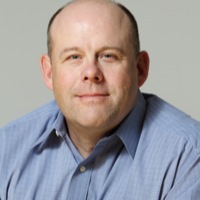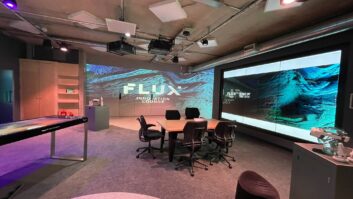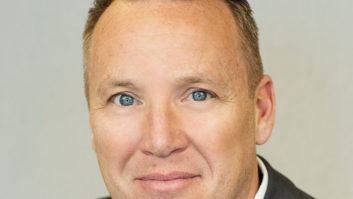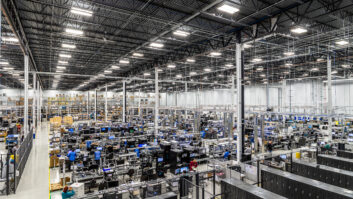
What was your first experience of the wireless technology industry, and what did you get from it?
My career started in wireless technology, but not necessarily the audio side of it. I used to work for Raytheon, where Martin Bodley [Revolabs co-founder] and I first came to know each other. Raytheon sent the two of us to complete a Master’s degree at the University of Massachusetts in Amherst, which had a very strong RF and microwave programme.
After that, I worked with wireless semiconductors for while. I then progressed into design and development of wireless chipsets before eventually marketing chipsets for companies like Ma-com and Analog Devices.
In the early days of my career, wireless was something cool, different and new; I grew up in the era where cellphones went from nothing to everywhere. In fact, that had been one of the factors that led us to starting up Revolabs.
A lot of unbelievable, great technology was born from the development of cellular phones. This rise produced a proliferation of the many different globally recognised wireless standards that governed the technology. It was these standards in particular that allowed wireless technology to grow and gave our company the opportunity to use the tried and tested technology to develop our own wireless microphone solutions.
What prompted you and Martin Bodley to start up Revolabs?
As I mentioned previously, Martin and I knew each from the wireless industry. Following our time at university and Raytheon together, Martin went off to a Danish company called GN Netcom, which produced the well-known Bluetooth headsets as part of its product line.
After he left there, him and I started to talk about some OEM [original equipment manufacture] work. Martin had heard negative feedback from customers in his previous role regarding audio quality at boardroom level, and this led to us start thinking about how we could solve the issue. We came up with the concept of getting the microphones off the table, out of the ceiling and away from the wire where they’re stationary, and moving them closer to the user. The way a microphone works is simple: the closer the device is to you, the better off your audio will be because the signal-to-noise will be better. Our company’s philosophy is ‘natural interaction’ – we wanted the user to be free to move around rather than be hunched over a wired mic.
The more we spoke with different companies and channel integrators, the more the problem became apparent. We even found that some very large companies had serious problems with audio quality at boardroom level.
With our combined backgrounds in wireless, Martin and I were able to come up with a wireless microphone solution. Of course there were already wireless microphones on the market, but no one had developed the technology for conference-room applications. We were able to bring the right technology into the boardrooms to attack the problem.
Initially we started off with multichannel systems for high-end boardrooms, which were all wearable, and the customer feedback was great. Now we’ve expanded to provide solutions from the desktop all the way through to the boardroom, with the addition of network compatible options.
How has the industry changed during Revolabs’ lifetime in terms of applications?
When we first started to sell to the high-end corporate boardrooms, people were happy were buying single products and combining them with products from other companies. For example, you’d have a microphone solution purchased from ourselves and then the DSP box from elsewhere.
Several of the big players have now entered into the industry pushing the Unified Communications banner, putting more pressure on the other companies. People don’t look at it as ‘products’ anymore, they’re now ‘solutions’. An exception to his would be in the corporate boardrooms because the integrators and architects design in a product manner rather than solution.
But there is a crossover starting to happen which is getting higher and higher up the application areas. People are now viewing audio in their conference rooms as part of a bigger solution or a bigger system within the building.
To an extent we have created a boardroom solution but not on the scale of the bigger players. Our newest generation of product, the HD family – which has essentially taken over from Solo – incorporates network integration so you can remotely monitor and control the box from outside your network or within your network.
As a manufacturer how significant an issue are differences in regulatory frameworks, frequency bands and so on in different territories around the world?
This comes back to how we design the product and its technology. A lot of the guys in the pro audio space have UHF/VHF licensed bands, whereas we use the ISM band, which is an unlicensed band in the USA and most of the world.
Our frequency works at 1.9GHz, and there are variations in this frequency between the USA and Europe and different parts of the world, but the band itself is used worldwide.
This is a big thing for us because a lot of customers have a global presence; and typically if these companies want our audio solutions installed in an office in one country, then they often want a similar solution installed in an office in a different country. The way we operate is very different to using UHF/VHF where every country seems to have its own band of interest. Instead we have the solutions available to be compatible with worldwide applications.
How do you see Revolabs’ current position in the market, and how do you intend to develop it?
We’re developing products from the top to the bottom so that we can provide UC solutions. We are constantly looking towards these different places and applications where people are collaborating, whether it’s at your desktop, a small or large conference room, or a training room or auditorium. We ask ourselves if we have the right solutions available for those specific types of application.
For instance, we have a dual channel wireless mic that is made to plug into videoconferencing. We also have the FLX as the conference room standalone, which can also be integrated into a videoconferencing solution. When you get to the high end we have our HD family, we also have the Fusion, which is a mix between a conferencing station and a high-end audio product.
One of the great things we offer now, because we’re developing solutions from the desktop to the highest-end boardroom, is a simple microphone interface – we feel that is the key to enterprise because people don’t want to have to learn about the devices, they want to walk into a conference room or boardroom and be able to use the equipment available, instantly.
Do you think much will change now Martin has left the CEO’s chair?
Martin and I started the company and we did everything from day one, but I don’t think you’ll see a massive change in the company. We’ve brought in some extremely talented people over the past few months; Tim Root, who has previous experience working for Polycom’s video division, has come in as CTO. He’ll be leading up the business development side. We’ve also brought in a new COO to backfill for myself, Marc Cremer, who has an extensive background in wireless technology, software, and semiconductors, and has worked for companies such as Motorola in the past.
These guys are very seasoned and I think they’re going to bring a lot in to the picture, but at the same time nothing is set to change in terms of the culture of the company. We won’t lose Martin’s creativity at the high end because he’s still going to be part of the board and he’ll still have big part to play with the strategic running of the company.
What would you say has been you proudest achievement during your career?
I think I take great pride in just about anything I do, whether its designing a chip or working as part of a team and hitting a goal that we’ve set ourselves.
One standout, great moment for myself was when I went into an engineering company I used to work for and saw multiple of Revolabs systems in use in different areas. You have to bear in mind that engineering companies by nature are very reluctant to pay for anything when it comes to technology; the more engineers you have the more they recognise that they can make anything anyone else can – and having been an engineer my whole life I understand it.
Just hearing those engineers and other people talking about our products in such a positive way capped the achievement of co-founding Revolabs.
Do you have any unfulfilled ambitions?
Well I do and I might have to give up on it because I’m never going to be the power forward for the Boston Celtics! Unfortunately the gene pool has not been kind to me in that respect, still got about eight more inches to grow and I’m maybe 20 years too late. But it’s always good to have something to dream about.







